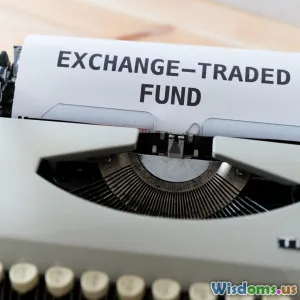
Which is Better for 2024 ETFs or Mutual Funds
9 min read Explore the 2024 investment showdown between ETFs and mutual funds to discover which suits your financial goals best. (0 Reviews)
Which is Better for 2024: ETFs or Mutual Funds?
Investing in 2024 presents fresh opportunities and challenges amid evolving markets and economic uncertainties. One crucial decision investors frequently face is choosing between Exchange-Traded Funds (ETFs) and Mutual Funds. Both have long dominated the retail and institutional investment landscapes, yet they differ significantly in costs, liquidity, tax implications, portfolio flexibility, and accessibility.
In this detailed guide, we unpack the intricacies of ETFs and mutual funds in 2024, aiming to provide you with valuable insights to navigate this popular investor question: Which investment vehicle better suits your financial aspirations this year?
Understanding ETFs and Mutual Funds
What Are ETFs?
ETFs are investment funds traded on stock exchanges, much like individual stocks. They hold a basket of securities—stocks, bonds, commodities—that mirror an index, sector, or other asset classes.
ETFs gained substantial traction due to their intra-day liquidity and generally lower expense ratios. For example, Vanguard’s S&P 500 ETF (VOO) offers broad exposure to large-cap U.S. stocks with expenses often under 0.05%, extremely cost-effective for index tracking.
What Are Mutual Funds?
Mutual funds pool investors' money to buy portfolios of securities. Unlike ETFs, they are typically priced once a day after the market closes, at the Net Asset Value (NAV).
Mutual funds span actively managed strategies aiming to outperform benchmarks, as well as passively managed index funds. The well-established Fidelity 500 Index Fund (FXAIX) is a mutual fund counterpart to S&P 500 ETFs.
Comparing Key Attributes of ETFs and Mutual Funds in 2024
1. Cost and Fees
Cost efficiency is a paramount consideration. ETFs usually have lower expense ratios due to their passively managed nature and lower operational costs. According to a 2023 Morningstar report, the average expense ratio for equity ETFs was around 0.20%, compared to 0.60% for equity mutual funds.
However, transaction costs can add up for ETFs if traded frequently, including brokerage commissions and bid-ask spreads. Many brokers eliminated commissions on ETF trades, reducing this barrier.
Mutual funds, meanwhile, can have front-load or back-end sales charges (also known as loads), though many no-load mutual funds exist now. Administrative fees and 12b-1 fees are often higher in mutual funds.
2. Tax Efficiency
ETFs stand out in tax efficiency due to their unique creation/redemption mechanism which reduces capital gains distributions. For investors, this translates to fewer unexpected tax liabilities.
According to a 2022 DALBAR study, taxable investors using ETFs saved an average of 20% on capital gains taxes compared with mutual fund investors.
Actively managed mutual funds, in particular, often generate significant capital gains distributions due to frequent portfolio turnover, which can trigger taxable events even if shares aren’t sold.
3. Liquidity and Trading Flexibility
ETFs trade on exchanges throughout the day like stocks, offering real-time pricing and instant execution. This flexibility enables investors to implement advanced trading strategies such as limit orders, stop losses, and intraday trading.
Mutual funds process orders only once per day at the closing NAV. This delays execution but prevents intra-day price volatility from influencing transactions.
For day traders or investors who value intraday decision-making, ETFs generally have the edge.
4. Minimum Investment Requirements
Mutual funds often require minimum initial investments, which range typically from $500 to $3,000 or more. This can be a hurdle for new or small-scale investors.
Conversely, ETFs allow you to buy as little as a single share, enabling fractional ownership with brokerages like Schwab or Fidelity offering fractional shares—an accessible path for beginners.
5. Investment Style: Active vs Passive
Many ETFs adhere to passive, index-tracking strategies, although in recent years, actively managed ETFs have emerged. Actively managed mutual funds remain the traditional playground for fund managers pursuing alpha.
If an investor believes in active management's potential benefits, mutual funds offer vast choices—though active ETFs are increasingly gaining competitive traction.
6. Transparency
ETFs publish their holdings daily, offering investors clear visibility into portfolio composition. This daily transparency is a significant advantage for monitoring risk and adjusting expectations.
Mutual funds disclose holdings less frequently, usually quarterly. For investors prioritizing real-time transparency, ETFs fit better.
Real-World Insights for 2024
Market Volatility Considerations
In the backdrop of heightened geopolitical risks and inflation concerns for 2024, ETFs' trading flexibility can allow tactical responses to sudden market moves.
For example, during volatile periods in late 2023, active traders often favored ETFs to exit or enter positions swiftly, a method less accessible with mutual funds.
Cost Trends
Large fund giants like Vanguard, BlackRock (iShares), and Fidelity continue lowering ETF fees, intensifying competition and value offered.
Notably, according to Vanguard’s 2023 financial summary, their ETF platform saw a 15% increase in assets year-over-year, indicating rising investor preference.
Tax Law Implications
Tax reforms affecting capital gains and dividend taxes scheduled for 2024 may magnify the tax benefits favoring ETFs, emphasizing strategic selection based on tax status.
Technology and Accessibility
Many brokerage platforms have enhanced user interfaces supporting seamless ETF purchases and fractional shares, lowering entry barriers.
Mutual funds remain fully accessible but sometimes lag in tech-driven innovations compared to ETFs.
Case Studies
Case Study 1: Long-Term Retirement Investor
Sarah, a 35-year-old planning for retirement with a 30-year horizon, values low costs and tax efficiency. She chooses a diversified ETF portfolio mainly comprising broad market ETFs and bond ETFs.
Over time, her portfolio benefits from low fees, tax losses harvesting strategies, and flexibility to rebalance quarterly.
Case Study 2: Investor Seeking Active Management
John prefers a hands-off approach but wants professional managers to select stocks outperforming benchmarks.
He opts for actively managed mutual funds with a consistent record. Despite higher fees, John values the potential for outperformance and convenience.
Conclusion: Which is Better in 2024?
Ultimately, the choice between ETFs and mutual funds hinges on your investment objectives, trading preferences, tax situation, and cost sensitivity.
- If low fees, intraday trading, tax efficiency, and transparency top your list, ETFs often emerge as the superior choice in 2024.
- If you prioritize active management, want automatic reinvestment options, and don’t frequently trade, mutual funds remain compelling.
As Morningstar’s direct of ETF Research in 2023, Christine Benz, summarized: "The decision increasingly depends on individual circumstances rather than universal superiority. Investors should evaluate how the product aligns with their goals."
Reflect on your financial goals, time horizon, and risk tolerance. Consider consulting a financial advisor to tailor your approach. There is no one-size-fits-all answer, but with the growing ETF ecosystem and evolving mutual fund landscape, 2024 offers exciting tools to refine your investment strategy.
Invest wisely, stay informed, and make 2024 a landmark year for your portfolio growth.
Rate the Post
User Reviews
Popular Posts




















